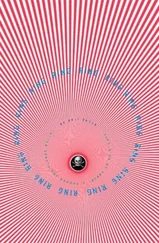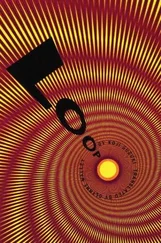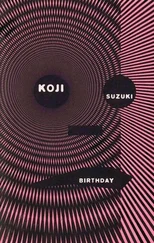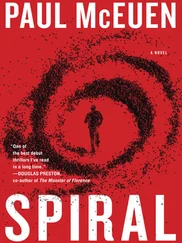Kojo Suzuki - Spiral
Здесь есть возможность читать онлайн «Kojo Suzuki - Spiral» — ознакомительный отрывок электронной книги совершенно бесплатно, а после прочтения отрывка купить полную версию. В некоторых случаях можно слушать аудио, скачать через торрент в формате fb2 и присутствует краткое содержание. Год выпуска: 2007, ISBN: 2007, Издательство: Harper, Жанр: Ужасы и Мистика, на английском языке. Описание произведения, (предисловие) а так же отзывы посетителей доступны на портале библиотеки ЛибКат.
- Название:Spiral
- Автор:
- Издательство:Harper
- Жанр:
- Год:2007
- ISBN:9780007240142
- Рейтинг книги:4 / 5. Голосов: 1
-
Избранное:Добавить в избранное
- Отзывы:
-
Ваша оценка:
- 80
- 1
- 2
- 3
- 4
- 5
Spiral: краткое содержание, описание и аннотация
Предлагаем к чтению аннотацию, описание, краткое содержание или предисловие (зависит от того, что написал сам автор книги «Spiral»). Если вы не нашли необходимую информацию о книге — напишите в комментариях, мы постараемся отыскать её.
Spiral — читать онлайн ознакомительный отрывок
Ниже представлен текст книги, разбитый по страницам. Система сохранения места последней прочитанной страницы, позволяет с удобством читать онлайн бесплатно книгу «Spiral», без необходимости каждый раз заново искать на чём Вы остановились. Поставьте закладку, и сможете в любой момент перейти на страницу, на которой закончили чтение.
Интервал:
Закладка:
In any case, the tape had been replicated in Asakawa’s apartment. Ando felt he needed to keep that in mind.
So Ryuji took the copy of the tape back to his apartment and started working on figuring out the erased message (he and Asakawa called this “the charm”). Both men wondered what this weird recording was doing in Villa Log Cabin B-4. At first they thought that it had been shot with a video camera and then left there, but that turned out not to be the case. Three days before the unfortunate youths, a family had stayed in B-4, they’d put a tape in the VCR and set it to RECORD. They’d then forgotten about it and left it there when they went home. So the images on the tape had not been shot elsewhere and the tape brought to the cabin: rather, some sort of unknown transmission had been captured on the tape when the machine was recording. The next people on the scene had been the four young victims. With time on their hands, they’d decided to watch a video; when they went to turn on the VCR, out popped a tape. They’d watched it. The threat at the end must have amused them. Like we’re really going to die in a week if we don’t do what it says? So they decided to play a trick by erasing the solution; that should scare the next guests. Of course, the kids never really believed in the tape’s curse. If they had, they never could have pulled such a stunt. In any case, the tape was found the next day by the manager, who put it on the shelf in the office, where it stayed unnoticed by anyone until Asakawa’s arrival.
So how had those images gotten into the deck while it was recording? It occurred to Asakawa that some maniac might have hijacked the airwaves, so he tried to pinpoint the source of such a broadcast. Meanwhile, when Asakawa was out of the house his wife and daughter found the video still in the VCR and watched it. Now Asakawa was urged on by the desire to save not only his own life, but also those of his family.
Then Ryuji made a startling discovery. Watching the tape over and over at home, he had a flash of inspiration. He made a chart and found that the tape could be broken down into twelve scenes, which fell into two groups: abstract scenes that seemed to consist of what might be called mental imagery, and real scenes that seemed to have been seen through an actual pair of eyes. For example, the volcanic eruption and the man’s face were clearly things that had really been seen, while the firefly-like light in the darkness at the beginning of the tape looked like something conjured up by the mind-like something out of a dream. So Ryuji called the two groups “real” and “abstract”, for comparison’s sake. Upon further investigation, he noticed that in the “real” scenes, there were instants in which the screen was covered by what looked like a black veil, just for a split second. In the “real” scenes, these instants occurred at the rate of about fifteen per minute, while in the “abstract” scenes, they didn’t appear at all. What did this mean? Ryuji concluded that the black veil was in reality a blink. It appeared in the scenes that were seen with actual eyes, and not in the sequences that were only seen in the mind’s eye. Not only that, the frequency of the blackouts matched the average eye-blinking frequency of a female. It seemed safe, then, to consider them eyeblinks. Which led naturally to the conclusion that the images on the videotape had not been captured by exposure in a video camera, but rather taken from the vision and imagination of an individual and placed on the tape by thought-projection.
Ando had real trouble believing this part. The idea that a person could mentally imprint images onto a videotape was simply preposterous. He might be willing, just barely, to allow the possibility of mentally imprinting photographic film, but moving images? That was an entirely different set-up, first of all. In order to press on, Ando had to lay this point aside for the moment, even as he admired Ryuji’s perspicacity.
Assuming that someone had recorded the tape paranormally, the next question was: who? Asakawa and Ryuji concentrated on that point, heading to the Tetsuzo Miura Memorial Hall in Kamakura. A researcher into parapsychological phenomena, Miura had devoted his life to tracking down paranormals from all over Japan. The files containing his findings were now housed in his memorial. The two men got permission to examine those files, over a thousand in number, thinking that a psychic with powers strong enough to project moving images onto a videotape couldn’t have escaped Professor Miura’s notice. And, after several hours of searching, they’d found a likely candidate.
Her name was Sadako Yamamura. She’d been born in the town of Sashikiji, on Izu Oshima Island.
According to an entry in her file, at the age of ten she was already able to project the characters yama (mountain) and sada, elements from her name, onto a piece of film. These very characters had appeared on the video. Certain that this Sadako Yamamura was who they were looking for, Ryuji and Asakawa boarded a boat for Izu Oshima the next morning. They hoped that learning more about her upbringing and personality would illuminate some of the secrets of the videotape. Sadako was threatening whoever looked at her images with death in order to get the viewer to do something. The tape itself embodied her wish for that action to be undertaken. Which made it crucial that they find out what Sadako desired. At this point, Ryuji already had an inkling that Sadako Yamamura was no longer alive. It was his belief that on the brink of death she’d unleashed her final, unfulfilled desire in the form of a psychic projection, meaning to relay her wish to someone else. Her deepseated hatred had ended up on the videotape.
Between the assistance of the Oshima stringer for the Daily News and the help of Yoshino in Tokyo, with whom they stayed in frequent contact, Asakawa and Ryuji managed to piece together a profile of Sadako Yamamura.
She was born in 1947, the daughter of Shizuko Yamamura, a one-time paranormal who had made a big but temporary splash in the national media, and Heihachiro Ikuma, an Assistant Professor of Psychiatry at Taido University who had gotten into research on parapsychology with Shizuko as his subject. At first, the trio of Ikuma, Shizuko, and Sadako had been received by the public with simple curiosity, and in fact had become media darlings after a fashion. But once a certain prestigious academic society had pronounced Shizuko’s powers fake, the masses turned on them, and they became subject to violent attacks in the media. Heihachiro was hounded out of the university, and eventually came down with tuberculosis, while Shizuko suffered nervous attacks and finally threw herself into Mt Mihara, the volcano on Izu Oshima.
Sadako was taken in by some relatives on the island, where she lived until she graduated from high school. Once in fourth grade she gained some notoriety within the school by predicting an eruption of Mt Mihara, but aside from that she didn’t display any of the powers she’d inherited from her mother. On leaving high school she moved to Tokyo, where she joined a theater troupe in hopes of making it as an actress. It was Yoshino who picked up her trail from there.
Asakawa called Yoshino from the island and asked him to find the troupe’s rehearsal space in Yotsuya, Tokyo. He did, and once there, he found out more about Sadako’s true nature from a man named Arima, a leader of the troupe. It had been twenty-five years since Sadako had been a member of his company, but he recalled her very well. She seemed to have some sort of supernatural power; she could project images at will onto the screen of an unplugged television. If this was true, then Sadako’s powers far outstripped her mother’s. While at the rehearsal space, Yoshino succeeded in obtaining a photo of Sadako. They still had her resume on file, and it contained two black-and-white photos from when she joined. One was from the waist up, while the other was a full-length shot. Both revealed Sadako to have perfectly balanced features that went beyond even the word “beautiful”.
Читать дальшеИнтервал:
Закладка:
Похожие книги на «Spiral»
Представляем Вашему вниманию похожие книги на «Spiral» списком для выбора. Мы отобрали схожую по названию и смыслу литературу в надежде предоставить читателям больше вариантов отыскать новые, интересные, ещё непрочитанные произведения.
Обсуждение, отзывы о книге «Spiral» и просто собственные мнения читателей. Оставьте ваши комментарии, напишите, что Вы думаете о произведении, его смысле или главных героях. Укажите что конкретно понравилось, а что нет, и почему Вы так считаете.












